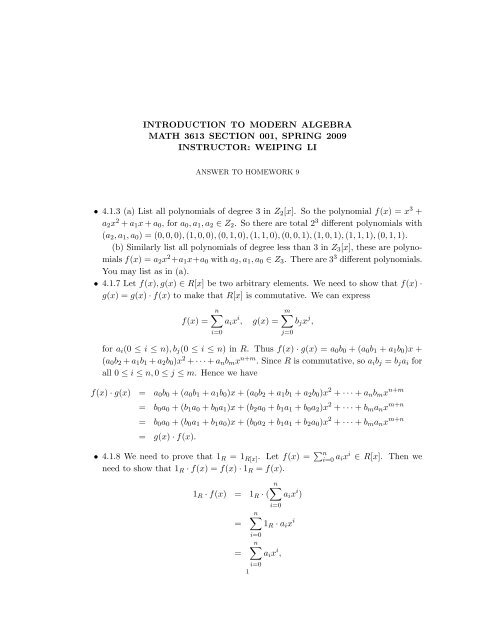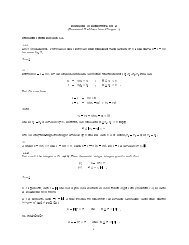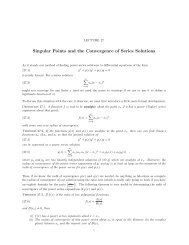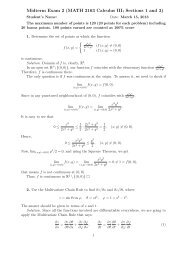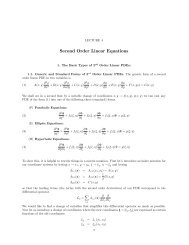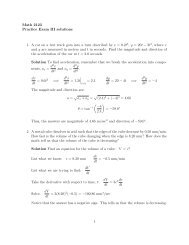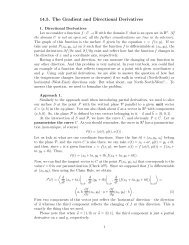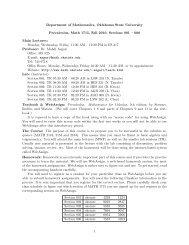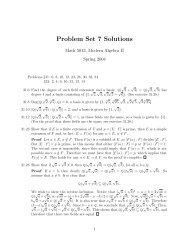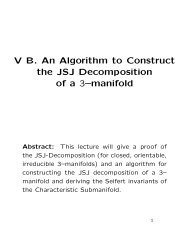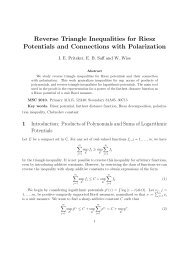INTRODUCTION TO MODERN ALGEBRA MATH 3613 SECTION ...
INTRODUCTION TO MODERN ALGEBRA MATH 3613 SECTION ...
INTRODUCTION TO MODERN ALGEBRA MATH 3613 SECTION ...
You also want an ePaper? Increase the reach of your titles
YUMPU automatically turns print PDFs into web optimized ePapers that Google loves.
<strong>INTRODUCTION</strong> <strong>TO</strong> <strong>MODERN</strong> <strong>ALGEBRA</strong><strong>MATH</strong> <strong>3613</strong> <strong>SECTION</strong> 001, SPRING 2009INSTRUC<strong>TO</strong>R: WEIPING LIANSWER <strong>TO</strong> HOMEWORK 9• 4.1.3 (a) List all polynomials of degree 3 in Z 2 [x]. So the polynomial f(x) = x 3 +a 2 x 2 + a 1 x + a 0 , for a 0 , a 1 , a 2 ∈ Z 2 . So there are total 2 3 different polynomials with(a 2 , a 1 , a 0 ) = (0, 0, 0), (1, 0, 0), (0, 1, 0), (1, 1, 0), (0, 0, 1), (1, 0, 1), (1, 1, 1), (0, 1, 1).(b) Similarly list all polynomials of degree less than 3 in Z 3 [x], these are polynomialsf(x) = a 2 x 2 +a 1 x+a 0 with a 2 , a 1 , a 0 ∈ Z 3 . There are 3 3 different polynomials.You may list as in (a).• 4.1.7 Let f(x), g(x) ∈ R[x] be two arbitrary elements. We need to show that f(x) ·g(x) = g(x) · f(x) to make that R[x] is commutative. We can expressf(x) =n∑m∑a i x i , g(x) = b j x j ,i=0j=0for a i (0 ≤ i ≤ n), b j (0 ≤ i ≤ n) in R. Thus f(x) · g(x) = a 0 b 0 + (a 0 b 1 + a 1 b 0 )x +(a 0 b 2 + a 1 b 1 + a 2 b 0 )x 2 + · · · + a n b m x n+m . Since R is commutative, so a i b j = b j a i forall 0 ≤ i ≤ n, 0 ≤ j ≤ m. Hence we havef(x) · g(x) = a 0 b 0 + (a 0 b 1 + a 1 b 0 )x + (a 0 b 2 + a 1 b 1 + a 2 b 0 )x 2 + · · · + a n b m x n+m= b 0 a 0 + (b 1 a 0 + b 0 a 1 )x + (b 2 a 0 + b 1 a 1 + b 0 a 2 )x 2 + · · · + b m a n x m+n= b 0 a 0 + (b 0 a 1 + b 1 a 0 )x + (b 0 a 2 + b 1 a 1 + b 2 a 0 )x 2 + · · · + b m a n x m+n= g(x) · f(x).• 4.1.8 We need to prove that 1 R = 1 R[x] . Let f(x) = ∑ ni=0 a ix i ∈ R[x]. Then weneed to show that 1 R · f(x) = f(x) · 1 R = f(x).1 R · f(x) = 1 R · (==n∑a i x i )i=0n∑1 R · a i x ii=0n∑a i x i ,i=01
2 ANSWER <strong>TO</strong> HOMEWORK 9since 1 R · a i = a i for a i ∈ R.f(x) · 1 R = (===n∑a i x i ) · 1 Ri=0n∑(a i x i · 1 R )i=0n∑a i · 1 R x ii=0n∑a i x i ,i=0where the second identity follows from the distribution law, the third from Theorem4.1 (ii) (So 1 R x i = x i 1 R since 1 R ∈ R), and the last from a i · 1 R = a i since a i ∈ R.• 4.1.9 If c ∈ R is a zero divisor, then c ≠ 0 R and there exists a d ≠ 0 R and d ∈ Rwith c · d = 0 R (since R is commutative, so c · d = d · c). Thus we can have bothc, d ∈ R[x]. Note that 0 R = 0 R[x] . So both c, d ≠ 0 R[x] and c · d = 0 R[x] . Orconstruct a polynomial d + dx ∈ R[x] which is ≠ 0 R[x] by Theorem 4.1 (v), andc · (d + dx) = cd + cdx = 0 R + 0 R x = 0 R = 0 R[x] . Hence it is also a zero divisor inR[x].• 4.1.11 By 4.1.7, F [x] is a commutative ring since F is a field. 1 F ≠ 0 F . By 4.1.8,we have 1 F [x] = 1 F ≠ 0 F = 0 F [x] . By Corollary 4.3, F [x] is an integral domain if Fis a field. So the only thing we need to verify that F [x] is not a field, is to find anonzero element in F [x] which has no inverse. The obvious nonzero element not inF is x by Theorem 4.1 for the construction of F [x]. We are going to show that x isnot a unit. Suppose the contrary. If x is a unit in F [x], then there exists an elementf(x) ∈ R[x] such that x · f(x) = f(x) · x = 1 F [x] = 1 F . By Theorem 4.2, we havedeg(x · f(x)) = deg(x) + deg f(x) = 1 + deg f(x), deg f(x) ≥ 0.deg(x · f(x)) = deg 1 F = 0.Thus 1 + deg f(x) = 0 which is impossible for a non-negative integer deg f(x). Thisleads to the claim that x is not a unit. Therefore F [x] is not a field.• 4.1.12. (i) If f(x) is a unit in F [x], then there exists g(x) ∈ F [x] such that f(x) ·g(x) = 1 F = g(x) · f(x). By Theorem 4.2, we havedeg f(x) + deg g(x) = deg(f(x) · g(x)) = deg 1 F = 0.For non-negative degree, we have deg f(x) = deg g(x) = 0.(ii) If deg f(x) = 0, then f(x)is a nonzero constant in F . Thus f(x) is a unit inF . We have a g ∈ F such that f(x) · g = g · f(x) = 1 F . Since g ∈ F ⊂ F [x] and1 F = 1 F [x] . So f(x) is also a unit in F [x]
<strong>MODERN</strong> <strong>ALGEBRA</strong> 3• 4.1.15 Since R is an integral domain, it is commutative with 1 R ≠ 0 R . We only needto prove that every nonzero element in R is a unit. Let b ≠ 0 R . Thus we can applythe Division Algorithm in R[x] for g(x) = b ≠ 0 R and f(x) = 1 R , there exist uniquepolynomials (q(x), r(x)) such that f(x) = 1 R = b · q(x) + r(x), and either r(x) = 0or deg r(x) < deg g(x). Since deg g(x) = deg b = 0, so r(x) must be zero. We have1 R = b · q(x).0 = deg 1 R = deg(b · q(x) = deg b + deg q(x) = deg q(x),by Theorem 4.2 for integral domain R. Hence deg q(x) = 0 if and only if q(x) = q ∈R is a nonzero constant in R. Therefore we have q ∈ R such that b · q = q · b = 1 R .So b is a unit, and R is a field.• 4.1.18 The derivative rule for product, shows that D(x · x 2 ) = D(x 3 ) = 3x 2 andD(x)·D(x 2 ) = 1·(2x) = 2x. So D(x·x 2 ) ≠ D(x)·D(x 2 ). D is a not homomorphismof rings, and is not an isomorphism.
4 ANSWER <strong>TO</strong> HOMEWORK 9• 4.2.2 Notice that the definition of gcd of f(x) and g(x) is a monic polynomial d(x)satisfies the Definition on page 91. So gcd(f(x), 0 F ) = c −1n · f(x).• 4.2.4 (a) If f(x)|g(x), then g(x) = f(x)p(x) and deg g(x) = deg f(x) + deg p(x) ≥deg f(x). Thus g(x)|f(x), we have deg f(x) ≥ deg g(x). This implies deg f(x) =deg g(x) and deg p(x) = 0. So p(x) is a nonzero constant in F . We denote it byc ∈ F .(b) From f(x) = cg(x), deg f(x) = deg g(x). Then for f(x) = x n + a 1 x n−1 + · · · +a n , g(x) = x n + b 1 x n−1 + · · · + b n , we havex n + a 1 x n−1 + · · · + a n = c(x n + b 1 x n−1 + · · · + b n ) = cx n + cb 1 x n−1 + · · · cb n .By Theorem 4.1 (iv), we have 1 F = c by comparing the coefficient of x n . Thereforef(x) = cg(x) = 1 F · g(x) = g(x) by 4.1.8.• 4.2.5(b) Applying the Euclidean Algorithem (Theorem 1.6) for a(x) = x 5 + x 4 +2x 3 − x 2 − x − 2 and b(x) = x 4 + 2x 3 + 5x 2 + 4x + 4, we havea(x) = b(x)q 0 (x) + r 0 (x),where q 0 (x) = x − 1 and r 0 (x) = −x 3 − x + 2.b(x) = r 0 (x)q 1 (x) + r 1 (x),where q 1 (x) = −x − 2 and r 1 (x) = 4x 2 + 4x + 8.r 0 (x) = r 1 (x)q 2 (x),where q 2 (x) = − 1 4 x+ 1 4 . Thus r 1(x) is the greatest common divisor. So gcd(a(x), b(x)) =14 (4x2 +4x+8) = x 2 +x+2 (Remember: gcd for polynomial must be monic. Answerr 1 (x) = 4x 2 + 4x + 8 is not monic so that it is incorrect!).• 4.2.9. If gcd(f(x), 0 F ) = 1 F , then by Theorem 4.5, there exist polynomials u(x), v(x)such thatf(x)u(x) + 0 F v(x) = 1 F .Hence f(x)u(x) = 1 F , and deg f(x) + deg u(x) = 0. This implies deg f(x) = 0. Sof(x) must be a nonzero constant in F .• 4.2.10. Do longdivision, or factor to see x + a + b is a factor of x 3 − 3abx + a 3 + b 3 .Thusgcd(x + a + b, x 3 − 3abx + a 3 + b 3 ) = x + a + b.• 4.2.14. If f(x)|h(x), then h(x) = f(x)p(x). If g(x)|h(x), then h(x) = g(x)q(x).Hencef(x)p(x) = h(x) = g(x)q(x).So g(x)|(f(x)p(x)). Since gcd(f(x), g(x)) = 1 F , by Theorem 4.7, g(x)|p(x). p(x) =g(x)l(x). Now we have h(x) = f(x)p(x) = f(x)g(x)l(x). So f(x)g(x)|h(x)..
<strong>MODERN</strong> <strong>ALGEBRA</strong> 5• 4.2.15. There are many ways to do this problem.Method 1. Let c(x) be a common factor of h(x) and g(x). Then h(x) = c(x)p(x)and f(x) = h(x)q(x) = c(x)p(x)q(x). So c(x) is a common factor of f(x) and g(x).So c(x) = 1 F from gcd(f(x), g(x)) = 1 F .Mehotd 2. By Theorem 4.5, there exist u(x), v(x) such thatf(x)u(x) + g(x)v(x) = 1 F .Since h(x)|f(x), there is a p(x) ∈ F [x] such that f(x) = h(x)p(x), andh(x)p(x)u(x) + g(x)v(x) = 1 F .Note that Theorem 4.5 is only for one direction to express gcd, but not necessaryf(x)u(x) + g(x)v(x) = d(x) = gcd(f(x), g(x)). 1 F is an exceptional case. Let c(x)be a common factor of h(x) and g(x), therefore h(x) = c(x)h 1 (x), g(x) = c(x)g 1 (x).andc(x)h 1 (x)p(x)u(x) + c(x)g 1 (x)v(x) = c(x) [h 1 (x)p(x)u(x) + g 1 (x)v(x)] = 1 F .Therefore c(x)|1 F and deg c(x) = 0. So c(x) must be a nonzero constant. Hencegcd(h(x), g(x)) = 1 F .


